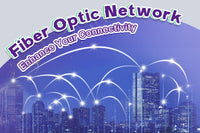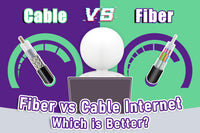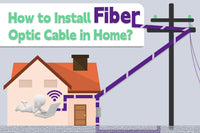Contents
With the rising demands for high-speed internet speed, such as VR and gaming, a new technology has emerged. Old network connections, including DSL and cable networks, are not capable of transferring and handling high speed. Fiber to the Home (FTTH) has proven to be an effective way of delivering large digital signals with no degradation over long distances. FTTH internet is a reliable alternative to copper-based internet, which enables the “last mile” of internet connectivity.
What is Fiber to the Home (FTTH)?
The history of FTTH can date back to the 1970s when the great benefits of FTTH networks were first recognized. General Telephone and Electronics (GTE) developed the first optical network in Southern California.
FTTH is an abbreviation of Fiber to the Home, which uses fiber optic cables to deliver high-speed internet access from the center location of internet service providers (ISPs) to individual households. FTTH provides a direct internet connection, ensuring a stable and fast network speed.
Compared to traditional networks like DSL and cable networks, FTTH networks use fiber optic cables instead of twisted pair or coaxial cables. These slim fibers enable faster and more efficient data transmission over long distances through light signals because they are neither susceptible to electromagnetic interference nor to signal loss.
With the increasing popularity of fiber optic networks, fiber-to-the-home has covered a larger share of the global market. Though they are still unavailable in many rural areas, fiber optic networks are future-proofing.
How Does FTTH Work?
FTTH works by running fiber optic cables to individual households. Internet service providers (ISPs) will install the fiber optic cables underground and then connect these cables to the network interface devices located at the outside of the house. The network interface equipment is a hub for fiber optic cables and then the cables will be connected to the optical network unit or terminal. The terminal converts the light signals into electrical signals and it is typically connected to the router, which allows the user to connect multiple devices, including computers and TVs.
Fiber to the Home (FTTH) Architecture
There are two main types of architectures in FTTH broadband connectivity: active optical networks (AONs) and passive optical networks (PONs). Standard FTTH networks primarily use PONs for their cost-effectiveness and high performance.
Active Optical Networks (AONs)
Active optical networks (AONs) utilize a point-to-point architecture, covering electrically powered switching equipment, such as routers or switch aggregators. These powered switching devices are used to directly transmit signals to specific subscribers. In AON networks, each subscriber has its own fiber optical line, and at least one switch or router aggregator. The switch can be opened or closed by multiple means to channel incoming and outgoing signals into the right place. Active optical networks are known for their flexibility and interoperability but they entail higher installation and maintenance costs.
Passive Optical Networks (PONs)
Passive optical networks (PONs) are a point-to-multipoint architecture using passive fiber optical splitters to collect and distribute signals to multiple end users. PONs are more cost-effective than AONs as they can serve various customers over a single fiber optic cable without deploying individual fibers for each household. They are common among FTTH implementations for their lower installation and maintenance costs. A PON structure in an FTTH network includes the following important parts:
- Optical Line Terminal (OLT): OLT is designed to serve more than one PON networks, and it is usually the start of a PON system. It can convert the electrical signal provided by the ISP into the fiber optic signal used in passive optical networks, and it also helps the multiplexing among conversion devices (ONTs or ONUs) located in the user’s premises.
- Optical Distribution Network (ODN): ODN forms the path between the OLT at the center office and the ONT at the user’s premises. ODN is a crucial component in the PON system, consisting of five parts, including feeder fiber, optical distribution point, distribution fiber, optical access point, and drop fiber. The feeder fiber is used to connect the optical distribution frame (ODF) to the optical distribution point over a long distance. Distribution fiber optic cables connect the optical distribution point and the optical access point and distribute fibers to different areas. The drop fiber connects optical access points to ONTs in the user’s home. A quality ODN can facilitate high-speed data transmission to multiple end-users over long distances.
- Optical Network Terminal (ONT) / Optical Network Unit (ONU): ONT and ONU are almost the same but the former is in ITU-T terminology and the latter is an IEEE standard. They are designed to convert optical signals into electrical signals and are located between OLTs and users.

What Are the Benefits of FTTH?
As a broadband connection type, FTTH is an effective way of transmitting high-speed data over long distances. They offer many benefits:
- High Speed
Thanks to the high bandwidth capacity of fiber, FTTH can support high network speed, up to gigabit or even terabit per second. The fiber optic network allows you to download and upload large files or high-definition videos very quickly. With a high data rate, FTTH is widely applicable in high-bandwidth and data-density activities.
- Low Latency
FTTH internet usually has a lower latency than cable internet. So it has improved performance on streaming, online gaming, video conferencing, cloud computing, and other real-time online activities.
Note: What is latency?
Network latency refers to the time required to transfer data packet between point A and point B. Network latency is usually the delay in data transmission measured in milliseconds.
- Great Reliability
Another benefit of FTTH is its ability to resist external interference. Because optical fibers carry light signals instead of electrical signals, they are less susceptible to electromagnetic interference and radio frequency interference. This makes FTTH provide a stable and reliable network connection with no interrupts and outages.
- Symmetrical Speeds
One of the biggest features of FTTH network is that it offers symmetrical speeds, which means users can upload files and photos just as quickly as they can download them. The equal download and upload speeds make it an efficient choice for many activities. It can benefit those people who often attend online conference, enjoy VR gaming, and often use TikTok or Instagram.
- Future-proofing
Fiber optic cables are designed for lasting use in a durable fiber optic infrastructure. They are weather-proof and water-proof, enabling the upgrades without requiring frequent repairs and replacements. In the long run, FTTH network is an optimal network connection for future applications and technologies.
FTTH vs. FTTB vs. FTTC vs. FTTN
There are several versions of FTTx. The specific type of FTTx depends on the terminal location of fiber optic cables. Besides FTTH, there are some other terms, such as FTTB, FTTC, and FTTN. Do you know what’s the difference between these terms?
- FTTH
FTTH refers to fiber-to-the-home, which means the fiber installation directly to individual households. FTTH offers a high bandwidth, allowing for the connection with multiple devices. It is one of the forms of fiber to the premises (FTTP).
- FTTB
FTTB (fiber-to-the-building) is an extension of FTTP technology. It is a broadband internet that can transfer fiber optical cables to a building. FTTB is often deployed in urban areas.
- FTTC
FTTC, also know as fiber-to-the-curb or fiber-to-the-cabinet. Fibers run from the center office in the telecommunication room to the location near the customer’s location, such as the street cabinet, curb, and utility pole. FTTC is faster than FTTN but not as fast as FTTH.
- FTTN
FTTN stands for fiber-to-the-node. In FTTN, fiber optic cables are terminated at nodes far from customer homes (closer to end users than the central office). The optical signals are sent to nodes via fibers, but in the last part of the connection, they are transmitted via copper or coaxial cables.
Fiber vs. Cable vs. DSL Internet
Compared to cable and DSL internet, Fiber internet provides reliable and fast speeds, suitable for HD video streaming, video conferencing, and online gaming. However, it’s not available in all areas and may cost more than other internet options.
Cable internet is usually bundled with the TV service for a lower price. It can provide download speeds between 100-300 Mbps but have slower upload speeds. Cable internet has more coverage than fiber network.
DSL internet transmits the slowest data via telephone lines. It is sufficient for basic needs like internet surfing and video streaming. DSL is the most affordable and widely available option among these networks.
Final Thoughts
FTTH network has now met some challenges. For example, the service provider should have enough access to deploy fibers, and constructing a complete fiber-based network is costly. Despite these downsides, such as high installation costs and limited availability, FTTH remains a future-proofing option for consumers and businesses, offering fast speeds and stable connections.
For more information on this topic, you can keep up on our blogs. While VCELINK offers general and basic information for our customers and other visitors to the website, it’s not professional advice.




Be the first one to comment.
Leave a comment